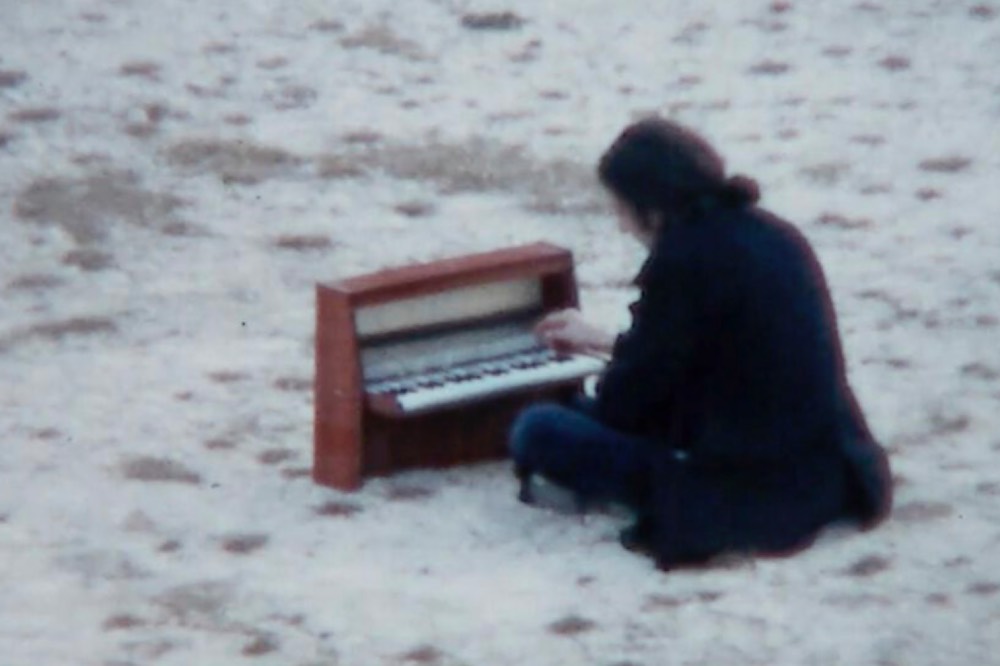Videoart at Midnight: # 145: Éric Baudelaire Eintritt frei | admission free
Éric Baudelaires films are partly made with the people whose experiences they explore revolutionary filmmakers and activists, teenagers, secessionists, and terrorists, all of whom have defied state institutions that assert the right to define reality. Their lives, their ethical choices, and their relationship to images are the exemplary materials of a cinema that rethinks the documentary form, and of an artistic practice that expands the films into broader display formats.
As the third of three collaborative events, Videoart at Midnight and Berlinische Galerie Museum of Modern Art are delighted to invite Éric Baudelaire to show two films with and about the work of the avant-garde composer Alvin Curran.
The Glove, 2020, 8 min
A confined rubber glove escapes out to the world in a time of pandemic. Its wandering through half-empty streets is set to an original musical score improvised by Alvin Curran.
When There Is No More Music to Write, and Other Roman Stories 2022, Color, Stereo, 4:3. 59:00 min
Rome, years of lead. Aldo Moro is kidnapped in the fervor of the Red Brigades. The armed struggle is propelled towards a political dead end. Alvin Curran, mythical figure of the musical Avant-Garde, strives to dissolve the figure of the author in the collective. The notion of instruments is extended to natural and everyday objects, producing revolutionary works.
Underneath the lengthy title of Éric Baudelaires new film, three films are hiding, separated by three credit rolls and three titles (Four Flat Tires, The Lost Score, and When There Is No More Music to Write). They evoke the figure of avant-garde composer Alvin Curran in his relationship to Rome, where he settled in the mid-1960s, and the music he created there, mainly within the famous Musica Elettronica Viva collective. But as the sub-title of the last of these films indicates of about Alvin Curran, the project is no less a portrait than a collaboration: Baudelaires collaboration with the composer, whom he never films in person, but whose thoughts and sounds he borrows; with his long-time editor, Claire Atherton; and with Maxime Guitton, a researcher involved in the project right from the start and who unearths priceless material. But Baudelaire also draws on Alvin Currans collaborations with his own companions, such as the underground filmmaker Annabella Miscuglio, of whom Baudelaire includes several films; with his city and his times, marked by the kidnapping of Aldo Moro and the revolutionary struggle. For it was in reaction to the discourses on the end of history and to the Years of Lead that Alvin Curran justified a musical art free from scored music and focussed on collaborative and performative processes. And to oppose political deadlocks and the death of cinema, Éric Baudelaire, in league with the oeuvre he documents, plays down the figure of the author and the pretension to an art as a single unit. Three times over the film ends and restarts, with the certainty that by replaying the end, everything can begin again " Antoine Thirion, Cinéma du Réel catalogue
Éric Baudelaire (1973) is an artist and filmmaker based in Paris, France. After training as a political scientist, Baudelaire established himself as a visual artist with a research-based practice incorporating photography, printmaking and video. Since 2010, filmmaking has become central to his work. His feature films A Flower in the Mouth, Un film dramatique, Also Known as Jihadi, Letters to Max, The Ugly one and The Anabasis of May and Fusako Shigenobu, Masao Adachi and 27 Years Without Images have circulated widely in film festivals (including Locarno, Toronto, New York, FIDMarseille and Rotterdam). When shown within exhibitions, Baudelaires films are part of broad installations that include works on paper, performance, publications and public programs, in projects such as Après at the Centre Pompidou in Paris, and The Secession Sessions, which began at Bétonsalon in Paris and traveled to Bergen Kunsthall, the Berkeley Art Museum and Sharjah Biennial 12. Baudelaire has had monographic exhibitions at the Witte de With [formerly known as], Rotterdam, Tabakalera, San Sebastian, the Fridericianum, Kassel, the Beirut Art Center, Gasworks, London, and the Hammer Museum in Los Angeles, and has participated in the 2017 Whitney Biennale, the 2014 Yokohama Triennale, Mediacity Seoul 2014, and the 2012 Taipei Biennial. In 2019 Baudelaire was the recipient of a Guggenheim Foundation Fellowship, and the Prix Marcel Duchamp "
